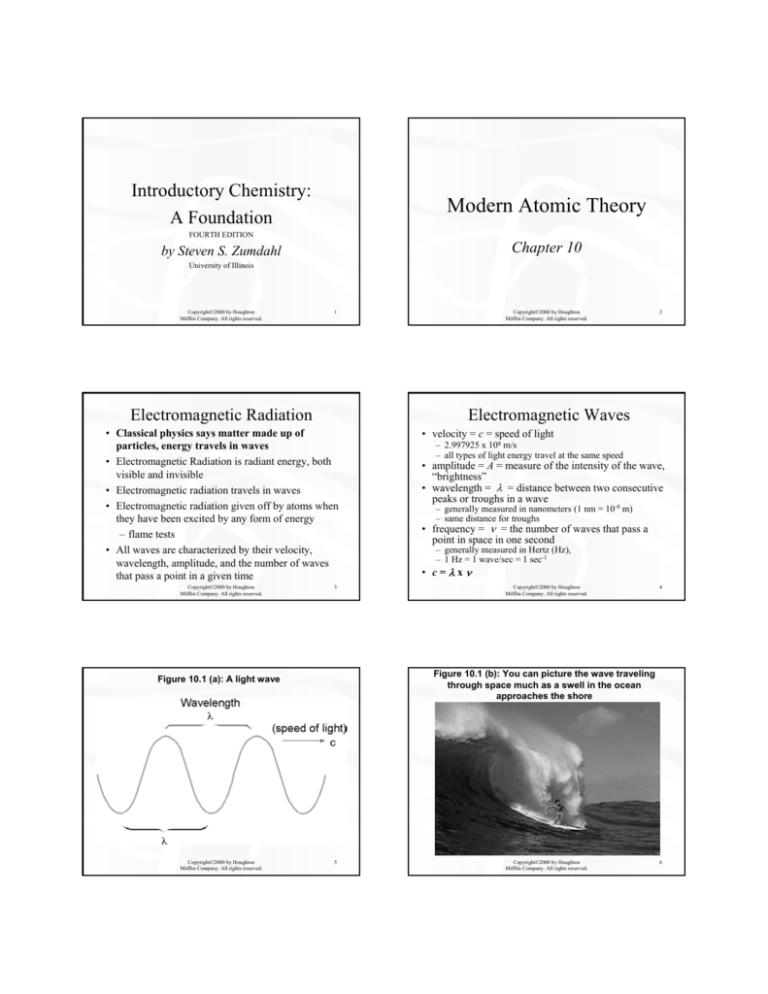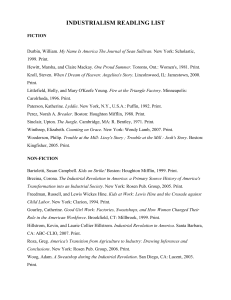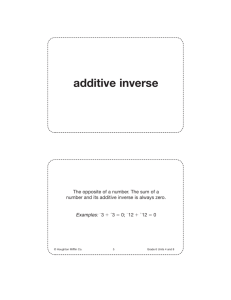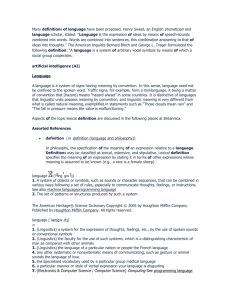
Introductory Chemistry:
A Foundation
Modern Atomic Theory
FOURTH EDITION
Chapter 10
by Steven S. Zumdahl
University of Illinois
Copyright©2000 by Houghton
Mifflin Company. All rights reserved.
1
Electromagnetic Radiation
3
• velocity = c = speed of light
– 2.997925 x 108 m/s
– all types of light energy travel at the same speed
• amplitude = A = measure of the intensity of the wave,
“brightness”
• wavelength = λ = distance between two consecutive
peaks or troughs in a wave
– generally measured in nanometers (1 nm = 10-9 m)
– same distance for troughs
• frequency = ν = the number of waves that pass a
point in space in one second
– generally measured in Hertz (Hz),
– 1 Hz = 1 wave/sec = 1 sec-1
• c=λxν
Copyright©2000 by Houghton
Mifflin Company. All rights reserved.
4
Figure 10.1 (b): You can picture the wave traveling
through space much as a swell in the ocean
approaches the shore
Figure 10.1 (a): A light wave
Copyright©2000 by Houghton
Mifflin Company. All rights reserved.
2
Electromagnetic Waves
• Classical physics says matter made up of
particles, energy travels in waves
• Electromagnetic Radiation is radiant energy, both
visible and invisible
• Electromagnetic radiation travels in waves
• Electromagnetic radiation given off by atoms when
they have been excited by any form of energy
– flame tests
• All waves are characterized by their velocity,
wavelength, amplitude, and the number of waves
that pass a point in a given time
Copyright©2000 by Houghton
Mifflin Company. All rights reserved.
Copyright©2000 by Houghton
Mifflin Company. All rights reserved.
5
Copyright©2000 by Houghton
Mifflin Company. All rights reserved.
6
Figure 10.2: The different wavelengths of
electromagnetic radiation
Types of Electromagnetic Radiation
• Radiowaves = λ > 0.01 m, low frequency and energy
• Microwaves = 10-4m < λ < 10-2m
• Infrared (IR)
– far = 10-4 < λ < 10-5m
– middle = 10-5 < λ < 2 x 10-6m
– near = 2 x 10-6 < λ < 8 x 10-7m
• Visible = 8 x 10-7 < λ < 4 x 10-7m
– ROYGBIV
• Ultraviolet (UV)
– near = 4 x 10-7 < λ < 2 x 10-7m
– far = 2 x 10-7 < λ < 1 x 10-8m
• X-rays = 10-8 < λ < 10-10m
• Gamma rays = λ < 10-10
Copyright©2000 by Houghton
Mifflin Company. All rights reserved.
7
Copyright©2000 by Houghton
Mifflin Company. All rights reserved.
8
Figure 10.3: Electromagnetic radiation
Planck’s Revelation
• Showed that light energy could be thought
of as particles for certain applications
• Stated that light came in particles called
quanta or photons
• Particles of light have fixed amounts of
energy
– Basis of quantum theory
• The energy of the photon is directly
proportional to the frequency of light
– Higher frequency = More energy in photons
Copyright©2000 by Houghton
Mifflin Company. All rights reserved.
9
Problems with Rutherford’s
Nuclear Model of the Atom
10
Atomic Spectra
• Atoms which have gained extra energy release that
energy in the form of light
• The light atoms give off or gain is of very specific
wavelengths called a line spectrum
• Electrons are moving charged particles
• Moving charged particles give off energy
• Therefore the atom should constantly be
giving off energy
• And the electrons should crash into the
nucleus and the atom collapse!!
Copyright©2000 by Houghton
Mifflin Company. All rights reserved.
Copyright©2000 by Houghton
Mifflin Company. All rights reserved.
– light given off = emission spectrum
– light energy gained = absorption spectrum
– extends to all regions of the electromagnetic spectrum
• Each element has its own line spectrum which can
be used to identify it
11
Copyright©2000 by Houghton
Mifflin Company. All rights reserved.
12
Figure 10.5: (a) A sample of H atoms receives energy from an external
source, which causes some of the atoms to become excited (to possess
excess energy). (b) The excited atoms (H) can release the excess energy
by emitting photons. The energy of each emitted photon corresponds
exactly to the energy lost by each excited atom.
Copyright©2000 by Houghton
Mifflin Company. All rights reserved.
13
Figure 10.7: When excited hydrogen atoms return to
lower energy states, they emit photons of certain
energies, and thus certain colors
Copyright©2000 by Houghton
Mifflin Company. All rights reserved.
Figure 10.6: When an excited H atom returns to a
lower energy level, it emits a photon that contains
the energy released by the atom
15
Figure 10.9: Each
photon emitted by
an excited
hydrogen atom
corresponds to a
particular energy
change in the
hydrogen atom
Copyright©2000 by Houghton
Mifflin Company. All rights reserved.
14
Copyright©2000 by Houghton
Mifflin Company. All rights reserved.
16
Figure 10.8:
Hydrogen atoms
have several
excited-state
energy levels
Atomic Spectra
• The line spectrum must be related to energy
transitions in the atom.
– Absorption = atom gaining energy
– Emission = atom releasing energy
• Since all samples of an element give the exact
same pattern of lines, every atom of that element
must have only certain, identical energy states
• The atom is quantized
– If the atom could have all possible energies, then the
result would be a continuous spectrum instead of lines
Copyright©2000 by Houghton
Mifflin Company. All rights reserved.
17
Copyright©2000 by Houghton
Mifflin Company. All rights reserved.
18
Figure 10.10:
(a) Continuous
energy levels.
(b) Discrete
(quantized)
energy levels.
Figure 10.11: The difference between continuous
and quantized energy levels
Copyright©2000 by Houghton
Mifflin Company. All rights reserved.
19
Figure 10.12: Neils Hendrik David Bohr (1885-1962)
Copyright©2000 by Houghton
Mifflin Company. All rights reserved.
20
Bohr’s Model
• Explained spectra of hydrogen
• Energy of atom is related to the distance
electron is from the nucleus
• Energy of the atom is quantized
– atom can only have certain specific energy states
called quantum levels or energy levels
– when atom gains energy, electron “moves” to a
higher quantum level
– when atom loses energy, electron “moves” to a
lower energy level
– lines in spectrum correspond to the difference in
energy between levels
Copyright©2000 by Houghton
Mifflin Company. All rights reserved.
21
Figure 10.13: The Bohr model of the hydrogen atom
Copyright©2000 by Houghton
Mifflin Company. All rights reserved.
22
Bohr’s Model
• Atoms have a minimum energy called the ground state
– therefore they do not crash into the nucleus
• The ground state of hydrogen corresponds to having its
one electron in an energy level that is closest to the
nucleus
• Energy levels higher than the ground state are called
excited states
– the farther the energy level is from the nucleus, the
higher its energy
• To put an electron in an excited state requires the addition
of energy to the atom; bringing the electron back to the
ground state releases energy in the form of light
Copyright©2000 by Houghton
Mifflin Company. All rights reserved.
23
Copyright©2000 by Houghton
Mifflin Company. All rights reserved.
24
Bohr’s Model
Problems with the Bohr Model
• Distances between energy levels decreases as the
energy increases
– light given off in a transition from the second energy
level to the first has a higher energy than light given off
in a transition from the third to the second, etc.
– Electrons “orbit” the nucleus much like planets orbiting
the sun
• 1st energy level can hold 2e-1, the 2nd 8e-1, the 3rd
18e-1, etc.
– farther from nucleus = more space = less repulsion
• Only explains hydrogen atom spectrum
– and other 1 electron systems
• Neglects interactions between electrons
• Assumes circular or elliptical orbits for
electrons - which is not true
• The highest energy occupied ground state orbit is
called the valence shell
Copyright©2000 by Houghton
Mifflin Company. All rights reserved.
25
Wave Mechanical
Model of the Atom
Copyright©2000 by Houghton
Mifflin Company. All rights reserved.
26
Copyright©2000 by Houghton
Mifflin Company. All rights reserved.
28
Figure 10.14: A
representation
of the photo of
the firefly
experiment
• Experiments later showed that electrons could be
treated as waves
– just as light energy could be treated as particles
– de Broglie
• The quantum mechanical model treats electrons as
waves and uses wave mathematics to calculate
probability densities of finding the electron in a
particular region in the atom
– Schrödinger Wave Equation
– can only be solved for simple systems, but approximated for
others
Copyright©2000 by Houghton
Mifflin Company. All rights reserved.
27
Figure 10.15:
The probability
map, or orbital,
that describes
the hydrogen
electron in its
lowest possible
energy state
Orbitals
• Solutions to the wave equation give regions in space
of high probability for finding the electron - these
are called orbitals
– usually use 90% probability to set the limit
– three-dimensional
• Orbitals are defined by three integer terms that are
added to the wave equation to quantize it - these are
called the quantum numbers
• Each electron also has a fourth quantum number to
represent the direction of spin
Copyright©2000 by Houghton
Mifflin Company. All rights reserved.
29
Copyright©2000 by Houghton
Mifflin Company. All rights reserved.
30
Orbitals and Energy Levels
Figure 10.16: The hydrogen 1s orbital
• Principal energy levels identify how much energy
the electrons in the orbital have
– n
– higher values mean orbital has higher energy
– higher values mean orbital has farther average distance
from the nucleus
• Each principal energy level contains one or more
sublevels
– there are n sublevels in each principal energy level
– each type of sublevel has a different shape and energy
– s<p<d<f
• Each sublevel contains one or more orbitals
– s = 1 orbital, p = 3, d = 5, f = 7
Copyright©2000 by Houghton
Mifflin Company. All rights reserved.
31
Figure 10.17: The first
four principal energy
levels in the hydrogen
atom
Copyright©2000 by Houghton
Mifflin Company. All rights reserved.
Copyright©2000 by Houghton
Mifflin Company. All rights reserved.
32
Figure 10.18: Principal levels can be divided into
sublevels
33
Figure 10.19:
Principal level
2 shown
divided into the
2s and 2p
sublevels
Copyright©2000 by Houghton
Mifflin Company. All rights reserved.
34
Figure 10.20: The relative sizes of the 1s and 2s
orbitals of hydrogen
Copyright©2000 by Houghton
Mifflin Company. All rights reserved.
35
Copyright©2000 by Houghton
Mifflin Company. All rights reserved.
36
Figure 10.21: The three 2p orbitals: (a) 2px, (b) 2pz,
(c) 2py.
Copyright©2000 by Houghton
Mifflin Company. All rights reserved.
Figure 10.22: A diagram of principal energy levels 1
and 2 showing the shapes of orbitals that compose
the sublevels
37
Copyright©2000 by Houghton
Mifflin Company. All rights reserved.
Figure 10.23: The relative sizes of the spherical 1s,
2s, and 3s orbitals of hydrogen
Figure 10.24: The shapes and labels of the five 3d
orbitals
Copyright©2000 by Houghton
Mifflin Company. All rights reserved.
Copyright©2000 by Houghton
Mifflin Company. All rights reserved.
39
40
Orbitals, Sublevels & Electrons
Pauli Exclusion Principle
• for a many electron atom, build-up the energy
levels, filling each orbital in succession by energy
• ground state
• 1s < 2s < 2p < 3s < 3p < 4s < 3d < 4p < 5s < 4d <
5p < 6s < 4f < 5d < 6p < 7s < 5f < 6d < 7p
• degenerate orbitals are orbitals with the same
energy
• No orbital may have more than 2 electrons
• Electrons in the same orbital must have
opposite spins
• s sublevel holds 2 electrons
• p sublevel holds 6 electrons
• d sublevel holds 10 electrons
• f sublevel holds 14 electrons
Copyright©2000 by Houghton
Mifflin Company. All rights reserved.
38
– each p sublevel has 3 degenerate p orbitals
– each d sublevel has 5 degenerate d orbitals
– each f sublevel has 7 degenerate f orbitals
41
Copyright©2000 by Houghton
Mifflin Company. All rights reserved.
42
Hund’s Rule
• for a set of degenerate orbitals, half fill each orbital
first before pairing
• highest energy level called the valence shell
– electrons in the valence shell called valence electrons
– electrons not in the valence shell are called core electrons
– often use symbol of previous noble gas to represent core
electrons
1s22s22p6 = [Ne]
Copyright©2000 by Houghton
Mifflin Company. All rights reserved.
43
• Elements in the same column on the
Periodic Table have
– Similar chemical and physical properties
– Similar valence shell electron configurations
• Same numbers of valence electrons
• Same orbital types
• Different energy levels
Copyright©2000 by Houghton
Mifflin Company. All rights reserved.
44
Figure 10.25: The electron configurations in the
sublevel last occupied for the first eighteen
elements
s1
1
2
3
4
5
6
7
Electron Configuration
s2
p1 p2 p3 p4 p5 s2
p6
d1 d2 d3 d4 d5 d6 d7 d8 d9 d10
f1 f2 f3 f4 f5 f6 f7 f8 f9 f10 f11 f12 f13 f14
Copyright©2000 by Houghton
Mifflin Company. All rights reserved.
45
Copyright©2000 by Houghton
Mifflin Company. All rights reserved.
46
Figure 10.26: Partial electron configurations for the
elements potassium through krypton
Figure 10.27: The orbitals being filled for elements
in various parts of the periodic table
Copyright©2000 by Houghton
Mifflin Company. All rights reserved.
Copyright©2000 by Houghton
Mifflin Company. All rights reserved.
47
48
Figure 10.29: The positions of the elements
considered in Example 10.3
Figure 10.28: A box diagram
showing the order in which
orbitals fill to produce the
atoms in the periodic table
Copyright©2000 by Houghton
Mifflin Company. All rights reserved.
49
Figure 10.30: The periodic table with atomic symbols,
atomic numbers, and partial electron configurations
Copyright©2000 by Houghton
Mifflin Company. All rights reserved.
50
The Modern Periodic Table
• Columns are called Groups or Families
• Rows are called Periods
– Each period shows the pattern of properties
repeated in the next period
• Main Groups = Representative Elements
• Transition Elements
• Bottom rows = Lanthanides and Actinides
– really belong in Period 6 & 7
Copyright©2000 by Houghton
Mifflin Company. All rights reserved.
51
Copyright©2000 by Houghton
Mifflin Company. All rights reserved.
52
Metallic Character
• Metals
• Metalloids
– malleable & ductile
– shiny, lustrous
– conduct heat and
electricity
– most oxides basic
and ionic
– form cations in
solution
– lose electrons in
reactions - oxidized
Metallic Character
• Nonmetals
9 Also known as
semi-metals
9 Show some
metal and some
nonmetal
properties
Copyright©2000 by Houghton
Mifflin Company. All rights reserved.
9 brittle in solid state
9 dull
9 electrical and
thermal insulators
9 most oxides are
acidic and molecular
9 form anions and
polyatomic anions
9 gain electrons in
reactions - reduced
53
• Metals are found on the left of the table,
nonmetals on the right, and metalloids in between
• Most metallic element always to the left of the
Period, least metallic to the right, and 1 or 2
metalloids are in the middle
• Most metallic element always at the bottom of a
column, least metallic on the top, and 1 or 2
metalloids are in the middle of columns 4A, 5A,
and 6A
Copyright©2000 by Houghton
Mifflin Company. All rights reserved.
54
Figure 10.31: The classification of elements as
metals, nonmetals, and metalloids
Reactivity
• Reactivity of metals increases to the left on
the Period and down in the column
– follows ease of losing an electron
• Reactivity of nonmetals (excluding the
noble gases) increases to the right on the
Period and up in the column
Copyright©2000 by Houghton
Mifflin Company. All rights reserved.
55
Trend in Ionization Energy
• Minimum energy needed to remove a valence electron
from an atom
– gas state
Copyright©2000 by Houghton
Mifflin Company. All rights reserved.
56
Trend in Atomic Size
• Increases down column
• The lower the ionization energy, the easier it is to
remove the electron
– valence shell farther from nucleus
• Decreases across period
– meatls have low ionization energies
– left to right
– adding electrons to same valence shell
– valence shell held closer because more protons
in nucleus
• Ionization Energy decreases down the group
– valence electron farther from nucleus
• Ionization Energy increases across the period
– left to right
Copyright©2000 by Houghton
Mifflin Company. All rights reserved.
57
Copyright©2000 by Houghton
Mifflin Company. All rights reserved.
59
Figure 10.32:
Relative atomic
sizes for
selected atoms.
Note that
atomic size
increases down
a group and
decreases
across a period
Copyright©2000 by Houghton
Mifflin Company. All rights reserved.
58








